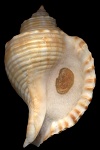|
The Genus Cymatium Röding, 1798 |
||||
|
|
||||
| Taxonomy:
The genus Cymatium
is but one of the 10 genera which make up the family
Ranellidae. The family is further divided into 15
subgenera which collectively include more than 150
species and subspecies. Of the 10 genera, the genus Cymatium
is by far the largest - consisting of 10 subgenera and
about 81 species and subspecies. Arrangement herein
generally follows that of Thomas Henning & Jens
Hemmen (Ranellidae & Personidae Of The
World - 1993); updated as appropriate. Habitat: Most Cymatium are found in relatively shallow water in tropical seas. However, some species are also found in temperate waters, and at times, in depths of up to 1,200 feet. Feeding habits: All Cymatium are carnivorous and normally feed on living ascidians, tube-worms, other mollusks, sea-cucumbers and starfish although carrion is not spurned. Most species first anesthetize their victims with secretions from the salivary gland prior to ingestion. This not only serves to immobilize the prey, but aids in the digestive process. Reproduction: The sexes are separate and fertilization takes place internally. The eggs are laid into cup-shaped receptacles called capsules. After hatching, the free-swimming larval stage of the offspring of several species lasts for several months, which fact accounts for extensive geographic ranges, some circumglobal. |
||||
|
Subgenera [type species shown] |
||||
 |
 |
 |
 |
 |
| Cymatium | Monoplex | Gelagna | Ranularia | Gutturnium |
 |
 |
 |
 |
 |
| Reticutriton | Linatella | Lotoria | Septa | Turritriton |

